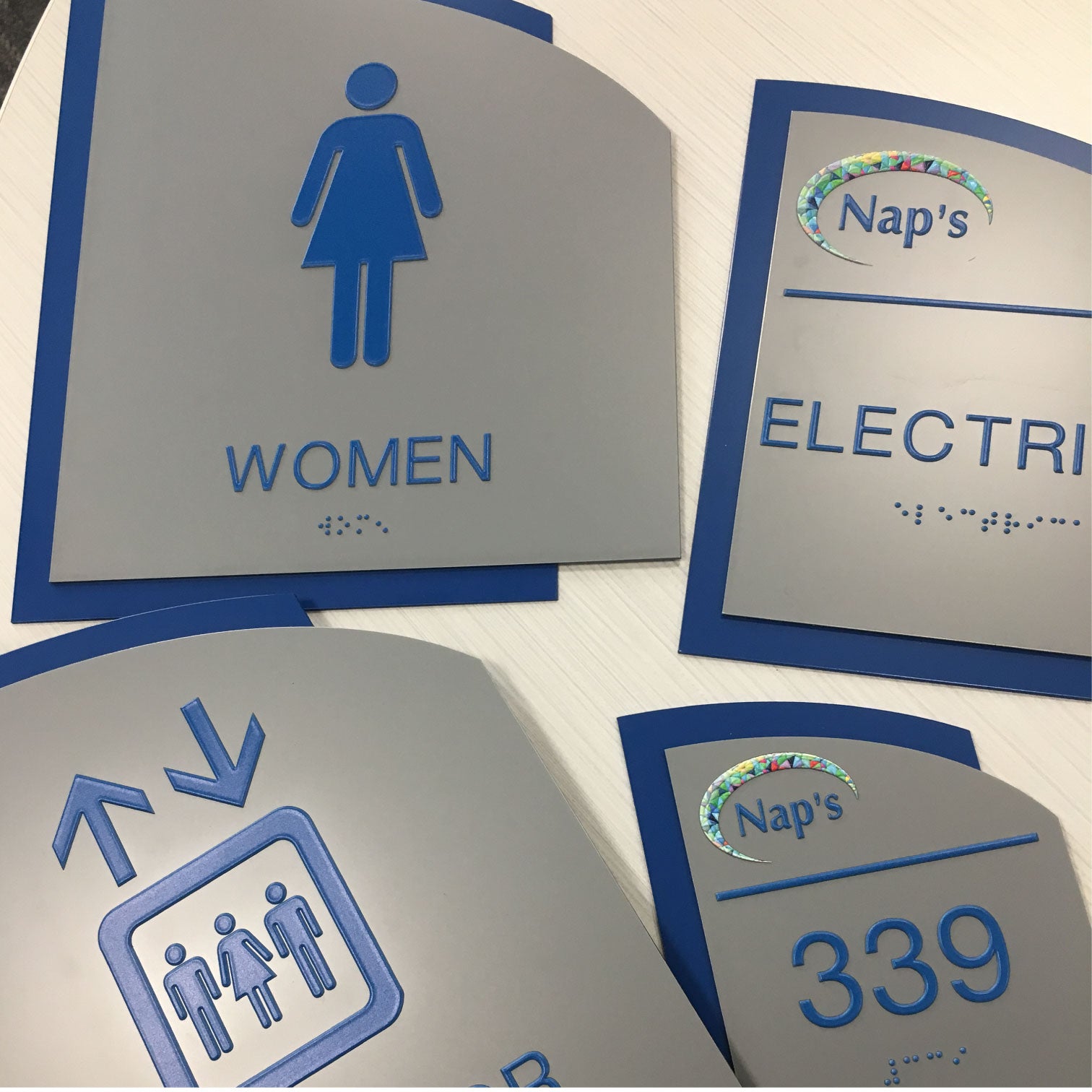A Comprehensive Overview to Picking the Right ADA Signs
Exploring the Secret Functions of ADA Indicators for Boosted Accessibility
In the world of access, ADA indications function as silent yet powerful allies, making sure that areas are navigable and comprehensive for people with impairments. By integrating Braille and responsive aspects, these signs damage obstacles for the visually damaged, while high-contrast color design and clear font styles accommodate diverse visual demands. Their critical positioning is not approximate however instead a calculated effort to assist in smooth navigation. Yet, beyond these attributes exists a much deeper story concerning the development of inclusivity and the ongoing commitment to developing equitable rooms. What extra could these signs represent in our search of global access?
Relevance of ADA Conformity
Ensuring conformity with the Americans with Disabilities Act (ADA) is essential for promoting inclusivity and equal access in public rooms and work environments. The ADA, established in 1990, mandates that all public facilities, employers, and transportation solutions suit individuals with specials needs, guaranteeing they enjoy the exact same rights and opportunities as others. Compliance with ADA standards not just meets lawful obligations yet likewise improves an organization's reputation by showing its commitment to diversity and inclusivity.
One of the vital aspects of ADA conformity is the execution of available signs. ADA indicators are made to make certain that individuals with impairments can quickly browse with areas and structures.
Furthermore, adhering to ADA guidelines can reduce the danger of potential penalties and legal effects. Organizations that fall short to adhere to ADA standards might encounter lawsuits or charges, which can be both destructive and economically challenging to their public photo. Thus, ADA conformity is indispensable to promoting an equitable atmosphere for everybody.
Braille and Tactile Elements
The unification of Braille and responsive elements right into ADA signs symbolizes the concepts of ease of access and inclusivity. It is usually placed beneath the equivalent message on signs to ensure that people can access the information without visual help.
Responsive elements extend beyond Braille and include raised icons and personalities. These components are developed to be noticeable by touch, allowing people to recognize area numbers, washrooms, departures, and other important locations. The ADA sets specific standards concerning the size, spacing, and positioning of these responsive aspects to maximize readability and guarantee consistency across different environments.

High-Contrast Color Plans
High-contrast color pattern play a critical role in enhancing the exposure and readability of ADA signs for individuals with visual problems. These schemes are essential as they make best use additional info of the distinction in light reflectance in between message and history, making sure that indicators are quickly discernible, even from a distance. The Americans with Disabilities Act (ADA) mandates the use of particular shade contrasts to suit those with limited vision, making it go an important element of conformity.
The efficacy of high-contrast shades hinges on their ability to attract attention in numerous lights conditions, consisting of poorly lit settings and locations with glare. Usually, dark message on a light background or light text on a dark background is employed to accomplish optimum comparison. Black message on a yellow or white background provides a raw visual distinction that helps in fast recognition and understanding.

Legible Fonts and Text Dimension
When taking into consideration the design of ADA signs, the choice of understandable fonts and ideal message size can not be overemphasized. The Americans with Disabilities Act (ADA) mandates that typefaces must be sans-serif and not italic, oblique, script, extremely attractive, or of unusual kind.
According to ADA standards, the minimum text elevation ought to be 5/8 inch, and it needs to boost proportionally with watching distance. Consistency in text size adds to a natural visual experience, assisting people Learn More Here in navigating settings effectively.
Moreover, spacing in between lines and letters is important to legibility. Appropriate spacing prevents characters from showing up crowded, boosting readability. By sticking to these standards, designers can dramatically enhance ease of access, guaranteeing that signage offers its desired objective for all individuals, no matter of their visual abilities.
Efficient Positioning Strategies
Strategic positioning of ADA signage is crucial for taking full advantage of accessibility and making sure compliance with lawful standards. ADA standards specify that signs must be placed at an elevation between 48 to 60 inches from the ground to ensure they are within the line of view for both standing and seated people.
In addition, indications should be put nearby to the lock side of doors to permit very easy recognition before access. Uniformity in sign positioning throughout a center boosts predictability, reducing confusion and enhancing total user experience.

Conclusion
ADA indicators play a vital duty in promoting access by incorporating functions that address the requirements of individuals with handicaps. Incorporating Braille and tactile components makes sure important information is easily accessible to the visually damaged, while high-contrast color design and readable sans-serif font styles improve visibility across numerous illumination conditions. Reliable positioning techniques, such as ideal placing elevations and strategic places, additionally facilitate navigating. These elements jointly promote a comprehensive atmosphere, underscoring the importance of ADA compliance in making certain equivalent gain access to for all.
In the realm of access, ADA indicators offer as silent yet effective allies, ensuring that areas are inclusive and navigable for individuals with specials needs. The ADA, passed in 1990, mandates that all public centers, employers, and transportation solutions fit people with specials needs, ensuring they take pleasure in the exact same civil liberties and chances as others. ADA Signs. ADA indications are created to make certain that individuals with impairments can conveniently navigate with rooms and structures. ADA guidelines state that indicators must be installed at a height between 48 to 60 inches from the ground to ensure they are within the line of view for both standing and seated individuals.ADA indicators play an important function in advertising accessibility by incorporating features that resolve the needs of individuals with disabilities